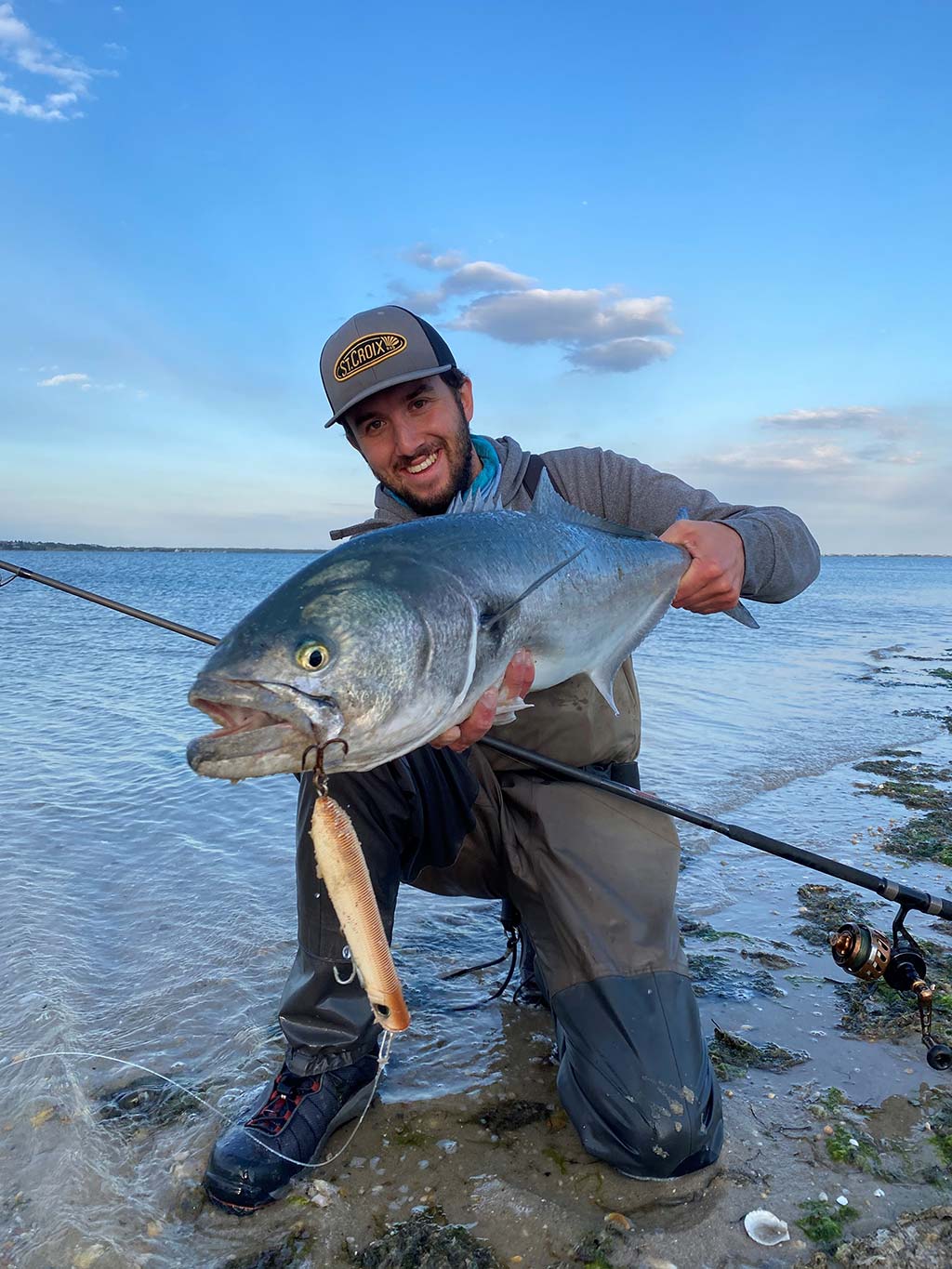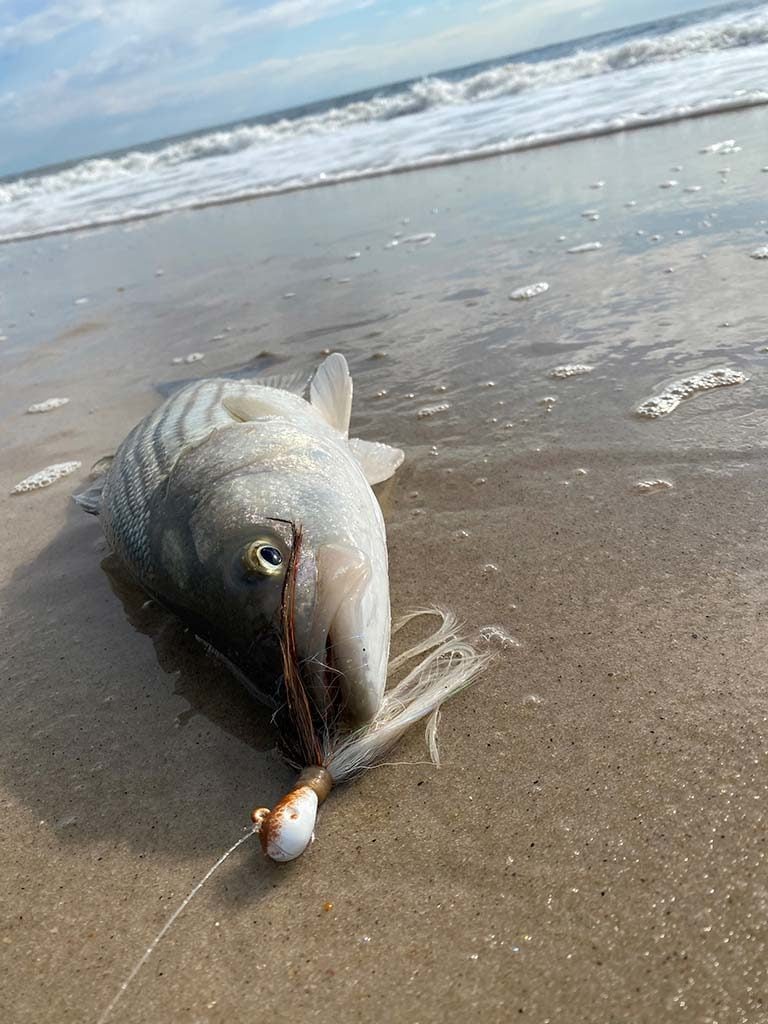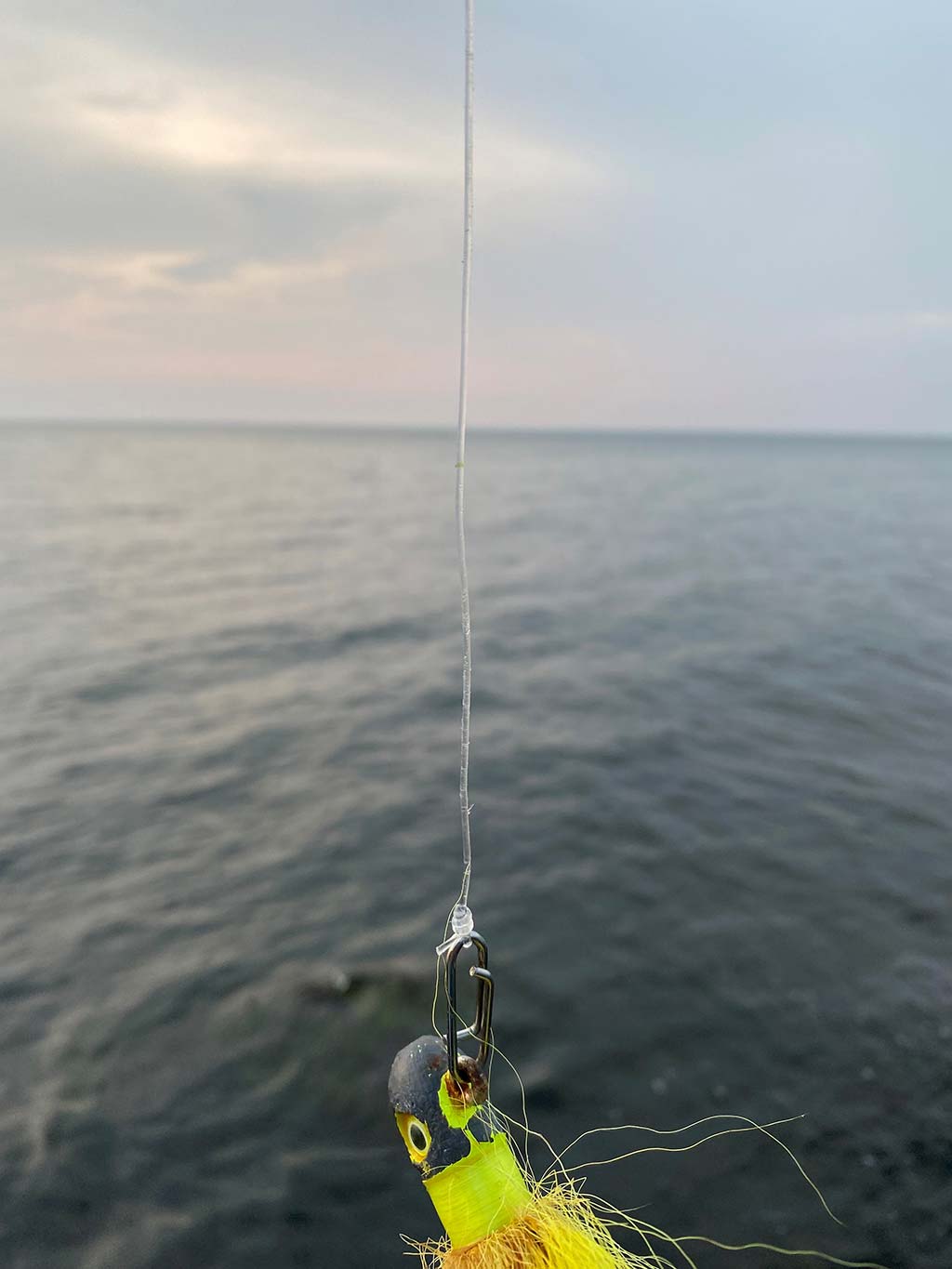I have my opinions on the subject from personal experience but what about the opinions and experiences from others?
Over the years while giving seminars on surf fishing it seemed that there was always one reoccurring question in every one I conducted. It happened to always be on the topic of leaders. How, when, why and multiple other sub-questions were generated on the topic. So many different cases and points can be made for leaders. It’s been a debated topic among surfcasters for years and I’m convinced the ins and outs of the surf leader will continue to be debated for years to come.
I have my opinions on the subject from personal experience but what about the opinions and experiences of others? I gathered insights from some of the Island’s hardest working and dedicated surf anglers who put in an immense amount of time. All these guys have been quite successful in their years of fishing and make great points. Here’s what they had to say on the topic.

Fred Golofaro
For most surf fishing situations, I prefer using a quality swivel like Spro’s Power Swivel in 75- or 80-pound sizes to connect my leader to the line. The swivel makes replacing frayed leaders much easier, especially at night when you are trying to minimize the use of your neck light. The only time I tie line to leader direct is when dropping down to light tackle and I extend my leader to 5 or 6 feet. For rods from 8 to 11 feet, I favor leaders from three to four feet and never less than three feet. In addition to protecting your main line from abrasion caused by rocks, sand, teeth, and gills, your leader serves as a reliable handle for helping land fish. Why they even sell pre-tied leaders of 12 and 18 inches is something I could never understand.
Fishing the surf requires we take advantage of any piece of equipment that might give us an edge or raise our confidence level for catching fish. Given that, fluorocarbon leaders seem the logical choice, however, it is much more expensive than monofilament and less friendly when it comes to tying knots, once you get above 30-pound test. It does provide an edge in abrasion resistance over mono. So, does it make a difference? If you believe it does, then by all means spring for the extra bucks. I lean heavily on fluorocarbon but am constantly reminded of all the success I’ve had over a large chunk of my life using pink Ande mono.
My leader wallet carries leaders of 20, 30, and 40-pound test. I have carried 50-pound leaders for situations in Montauk and on Block Island, but truth be told, I’ve rarely had to go that high. I prefer to replace or cut back a frayed leader over going to heavier, more visible leaders. Some very good casters out there don’t believe heavy leaders can reduce bites, going as high as 80-pound test at times. My own experiences over the past 60 or so years of fishing the surf tell me otherwise. l can point to many instances where lighter leaders made a difference, especially in calm and clear water, and even in the case of bluefish.
At the business end, I prefer to tie direct whenever I throw bucktails. Since I am often snap-jigging, I want the action I am imparting with my rod to transmit directly to the lure. Tying direct also provides a more natural presentation to a lure that is often taken less aggressively by stripers. Most of the time, you can barely feel the take. When it comes to tossing metals, topwaters, and swimming plugs, I like to go with a small and less visible, but strong enough snap, to handle the situation. Quick Clip type snaps rarely fail and make lure changing quick and easy. They are bulkier than Duo-Lock snaps and since I still have enough Duo-Locks to last two lifetimes, I frequently use them. Before tying one on, I check to make sure each one closes completely and securely or it goes in the garbage. The only time I have had them fail was when I got lazy and failed to tie direct to a bucktail. Bass would get the jig and snap in their mouth, and destroy the light wire Duo-Lock.
Nick Apostolides
So you have all your fancy gear, your fancy rods, and your fancy reels. You even make sure to put top-notch braided line on in the case of hooking into the fish of a lifetime. But braid alone will not withstand the test of the boulder fields and rock piles that our beloved striped bass are swimming around. So what do you do? This is where a monofilament or fluorocarbon leader comes into play. Here are my thoughts on setting mine up.
Many folks out there, even the most diehard surfcasters, insist on fluorocarbon for leader material. Now, with certain types of fishing, sure, fluorocarbon is the way to fly. But In the case of surf fishing for bass, I find it unnecessary. I can’t ever recall a time where I was being outfished because the guy next to me had fluorocarbon and I didn’t. I’m sure some anglers will argue against what I just stated but in my 15 years of throwing plugs off the beach, I have never found it to be needed. I have never used anything other than 50- or 60-pound monofilament leader. And to be frank, I never even cared what company made the mono. I use Ande pink or Trilene. Why these two? Because they were always easy to find and you get 900 yards for eight dollars.
Attaching your leader to your line is another thing guys will argue over time and time again. Many anglers will use a splicing knot to attach the braid to the leader. I avoid splicing it because tying an FG Knot, on a rock, in the wind, with the waves pounding you is a tedious task and a waste of time. My choice is a size 2 Spro barrel swivel rated to 230 pounds. I hear a lot of guys scoff at swivels which never made sense to me due to their ease of use. I’ve never had a swivel of that size give up on me either adding to my overall confidence.
Leader length is something else that guys will have their own confidence in. I prefer a leader greater than three feet. I want the leader to hit the rocks not my braid. Many people will tell you a long leader is only for the Montauk lighthouse. If you’re standing on a rock out of the water and are trying to land a fish, don’t you want a longer leader to grab rather than hanging onto braid? A 3-foot leader is typical but as I mentioned before I would much rather have a longer one.
Now it comes to attaching your plug to the leader. I see a ton of guys scold the use of a swivel and then at the end of their leader connected to their plug is a clip. This is a real head-scratcher to me. I’ve had clips fail multiple times. I tie all my plugs and lures directly to the leader material. When I want to change plugs, I cut off and retie. Over time my leader will get shorter and shorter. When it hits about 3-feet in length, I tie a new one on. It’s as simple as that. For those of you that haven’t had a clip fail yet, think about this…a 40-pound fish grabs your plug headfirst like they typically do and bites down with all its force. God forbid it bites that clip, it’s going to open. When a fish bites my knot, my knot stays where it is just as it is. The thought of losing a fish of that size due to an opening clip is something I can’t have.

Vinny Saccia
There are so many variables that come into play when choosing a leader and I like to make sure I’m always ready for a big fish. I like to keep it as simple as I can without compromising my chances. There are many knots you can tie that will do the job for big bass, but for me, I like something I can change out quickly in the harsh elements. The knot I use for everything is very simple, but effective. This is the common clinch knot.
The setup I use most of the time when fishing from the surf for striped bass is 40-pound braid to a 150-pound barrel swivel to a 60-pound monofilament leader with a 125-pound Tactical Anglers clip. I like a fairly long leader averaging anywhere from 40 to 50 inches. This helps me when landing fish from the rocks or in heavy surf. I will always keep 80-pound leaders tied up in my surf bag and typically will tie them on when fishing around a lot of rocks or when I come across a lot of big bluefish.
When throwing rigged or live eels or even soft plastic eel imitations, a heavy and long monofilament leader can help keep your eel gliding slowly just above the rocks because it will sink a little bit slower and give it a more natural presentation.
Having a good leader greatly increases your chances at landing big bass and checking your leader every so often or after every fish when fishing rocky terrain will make sure you aren’t casting with compromised line that could result in you losing that cow.
Brandon Sausele
In general, it’s always important to tailor your terminal tackle to the type of fishing you do and where you do it. So for me that would be along the lines of targeting big fish in the reefs and boulder fields of Montauk after dark. I need my terminal tackle to hold up to these extreme conditions.
To start, the mainline I run is 50-pound Suffix braid. Attached is my leader that consists of 80-pound monofilament around 3 to 4 feet long. Personally, I’ve been using Ande which has worked fine for all my outings. Again with this type of fishing in the boulder fields, the abrasion resistance of the heavier braid/mono along with the added breaking strength is paramount for me. Now the leader itself consists of a 220-pound Billfisher barrel swivel on top (tied using a Palomar knot) and a 125- or 175-pound Tactical Anglers clip on the bottom using the same knot. This whole setup is then tied to my mainline using a modified uni knot.
There are some polarizing views on the use of clips versus tying direct and yes, I’ve straightened 125-pound clips on big fish which could put doubt into my mind on using them. However, as I mentioned earlier it’s important to set yourself up based on the type of fishing you do. For me I have outings where the whole night I’m fighting a chest-high swell, landing fish at my torso, and duck diving into waves so re-tying every time you want to change a plug just isn’t feasible for the style of fishing I participate in. That quick two second transition of plugs between waves becomes a necessary tactic. Furthermore, I’ll always have pre-tied leaders so when I’m out there I’m never preoccupied with tying a setup, which both wastes time in a prime tide period and risks the chance of getting cleaned off your rock. I usually pre-tie around 200 to 250 leaders over the winter keeping a stack of 12 or so on me at a time.
I’m very obsessive about the quality and maintenance of my terminal tackle. The windows to stick that monster fish you’re after are becoming shorter and less frequent in the fishery, especially in recent seasons. If you were to lose it to a knot failure, frayed leader, bent snap, or lack of preparation you surely will be regretting and thinking about it for a long time.

Andrea Caruana
Most of the leaders I fish are on the heavy side with the pound test being either 50, 80, or on occasion 100-pound test monofilament. The only exception where I’ll fish lighter leader would be for smaller fish in the fall on the beach or back bays. Those settings call for 20 to 30 pound test, but for the most part the majority of the year I’ll have the heavier stuff tied on.
I see the heavy leaders as added security for fishing in abrasive environments while giving out other beneficial factors as well. I consider it a multipurpose tool. Not only for being a shock absorber or an “invisible” section of line distancing my mainline to the lure, but I’ll use it as a handling section of my line to either pull fish up on rocks or prevent my hand from being cut open by the sharp braided line.
I keep my leader set up real simple. It consists of a 36-inch section of line, a good quality swivel, and a 125- or 175-pound Tactical Anglers clip. I prefer to use regular monofilament instead of fluorocarbon leader material. For one it’s cheaper and two I just can’t see why you would have to use fluorocarbon while fishing a plug at night with two sets of treble hooks hanging off of it. I’m confident with the mono and haven’t had any issues with it.
If I’m fishing and I see or feel my leader is chafed or frayed I will change it out right away. It would be foolish to know your leader is compromised and make another cast just for it cost me a good fish. Your leader is one of the most crucial parts of your fishing presentation. It can potentially be a weak link if you don’t give it proper attention. The good news is a leader is a very controllable factor in your surfcasting routine. Give your leader preparation some time and make sure those knots are clean and tight. It will pay off when you hook a trophy fish.
Make It Your Own
Over the years I had a few different thoughts regarding a leader setup. At one point when using fluorocarbon, I convinced myself I was catching more fish from using it. I switched to monofilament when I ran out of fluorocarbon and my catch rate stayed the same and even went up in some cases so that blew my fluorocarbon theory out of the water. While stripers aren’t line shy to monofilament in Long Island waters, fluorocarbon does offer benefits such as less stretch for better hooksets and added abrasion resistance over monofilament so don’t count out the fluorocarbon. It still offers slight advantages. Seaguar’s new inshore fluorocarbon leader material does a nice job covering these advantages.
My personal leader wallet has 40-pound leaders for the sand beach, 60 for the inlets, and 80 for the boulder fields or when the gator blues make a showing. All the lengths are somewhere around the 4-foot range so I can easily use it as a handle when I have a fish hooked in it. A size 4 Spro barrel swivel (130 pounds) is at one end with a 125-pound Tactical Anglers clip at the other. I opt out of tying direct because time is everything during a bite. Sometimes the window is only 30 minutes. During that period I want to make every second count and I can personally tie on a pre-made leader much faster than tying direct in the dark.
Fishing with light tackle calls for a different setup for me. I’ve taken a page out of the Fred Golofaro playbook on that one. Light 20- to 30-pound leaders are my choice with a direct tie at the braid and lure end. The braided end sees a uni-to-uni knot while the lure end gets an improved clinch knot.
In the end, every single one of these casters made great points on the leader setups they fish. These guys all have plenty of large stripers under their belt to justify their thoughts. Now while they all have their thoughts, what I recommend is to take a little from each of these individuals and make a leader your own. Figure out what works best for you in the places you fish.




